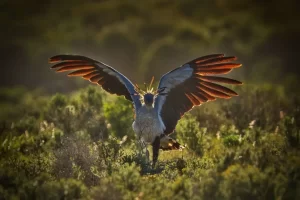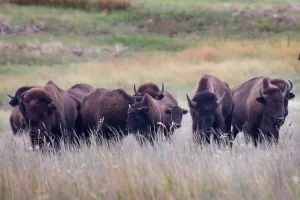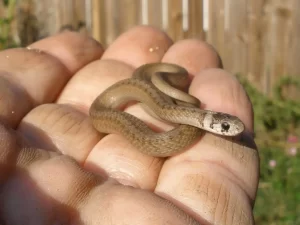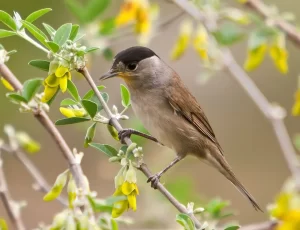The secretarybird is a large, mostly terrestrial bird of prey endemic to Africa. It has an unmistakable appearance with an eagle-like body on crane-like legs that give the bird a height of as much as 1.3 m (4 ft 3 in). Adults have a featherless red-orange face and predominantly grey plumage, with a flattened dark crest and black flight feathers and thighs. The sexes look similar to one another although the male tends to have longer tail feathers, more head plumes, a shorter head, and more blue-grey plumage.
Read Pritish article to enhance your knowledge about Secretarybird.

Distribution
Secretarybirds are found in sub-Saharan Africa and are generally non-migratory, though they may be locally nomadic as they follow rainfall and the resulting abundance of prey. Their range extends from Senegal to Somalia and south to Cape Province, South Africa. Secretarybirds prefer open grasslands, savannas, and shrubland (Karoo) rather than forests and dense shrubbery which may impede their cursorial existence.
Description
The secretarybird is instantly recognisable as a very large terrestrial bird with an eagle-like head and body on crane-like legs. It stands about 1.3 m (4 ft 3 in) tall. It has a length of between 1.1 and 1.5 m (3 ft 7 in and 4 ft 11 in) and a wingspan of between 1.9 and 2.1 m (6 ft 3 in and 6 ft 11 in). The weight ranges from 3.74 to 4.27 kg (8.2 to 9.4 lb), with a mean of 4.05 kg (8.9 lb). The tarsus averages 31 cm (12 in) and the tail is 57–85 cm (22–33 in): both factor into making it both taller and longer than any other species of raptor. The neck is not especially long, and can only be lowered down to the intertarsal joint, so birds must stoop to reach down to the ground.

SECRETARYBIRD – Description
During flight, two elongated central feathers of the tail extend beyond the feet, and the neck stretches out like a stork. The plumage of the crown, upperparts, and lesser and median wing coverts is blue-grey, and the underparts and underwing coverts are lighter grey to grey-white. The crest is made up of long black feathers arising from the nape. The scapulars, primary and secondary flight feathers, rump and thighs are black, while the uppertail coverts are white, though barred with black in some individuals. The tail is wedge-shaped with white tipping, marbled grey and black colouring at the base, and two broad black bands, one at the base and the other at the end.
Habits and Lifestyle
Secretarybirds are not generally gregarious aside from pairs and their offspring. They roost in trees and set off 1-2 hours after dawn, generally after spending some time preening. Mated pairs roost together but may forage separately, though often remaining in sight of one another. After spending much of the day on the ground, Secretarybirds return at dusk. Unlike most birds of prey, these birds hunt their prey on foot.
Adults hunt in pairs and sometimes as loose family flocks, stalking through the habitat with long strides. The birds often flush out prey from tall grass by stomping on the surrounding vegetation. Their crest feathers may raise during a hunt, which may serve to help scare the target and provide shade for the face. A bird will chase after prey with the wings spread and kill by striking with swift blows of the feet.

SECRETARY BIRD habit
Only with small prey items such as wasps will the bird use its bill to pick them directly. Occasionally, like other raptors, they will hold down a food item with their feet while tearing it apart with their bill.
Secretarybirds are normally silent but can utter a deep guttural croaking noise in nuptial displays or at nests. They make this sound when greeting their mates or in a threat display or fight against other birds, sometimes throwing their head backward at the same time. When alarmed, secretarybirds may emit a high-pitched croak. Mated pairs at the nest make soft clucking or whistling calls. Chicks make a sharp sound heard as ‘chee-uk-chee-uk-chee-uk’ for their first 30 days.
Diet and Nutrition
Secretarybirds are carnivores. Their diet consists of insects such as locusts and beetles, mammals ranging in size from mice to hares and mongoose, crabs, lizards, snakes, tortoises, small birds, bird eggs, and sometimes dead animals killed in grass or bush fires.
Mating Habits
Secretarybirds form monogamous pairs that last for life. They are territorial and defend a large area of around 50 km2 (19 sq mi). They can breed at any time of the year, more frequently in the late dry season. During courtship, they exhibit a nuptial display by soaring high with undulating flight patterns and calling with guttural croaking. Males and females can also perform a grounded display by chasing each other with their wings up and back, which is also the way they defend their territory.

SECRETARYBIRD – mating habits
The nest is built by both sexes at the top of a dense thorny tree, often an Acacia, at a height of between 2.5 and 13 m (8 and 40 ft) above the ground. The nest is constructed as a relatively flat platform of sticks lined with grass and the occasional piece of dung. The female lays the clutch of 1-3 elongated chalky bluish-green or white eggs. Both parents incubate the eggs that hatch after around 45 days and feed the young. The adults regurgitate food onto the floor of the nest and then pick up items and pass them to the chicks.
For the first 2 or 3 weeks after the eggs hatch the parents take turns to stay at the nest with the chicks. The young can stand up and feed after 40 days, although the parents still feed them after that time. At 60 days, the chicks start to flap their wings and typically leave the nest between 75 and 80 days of age. They will disperse from their natal range between 4 and 7 months old.
Population
Population threats
Although widespread, the secretarybird is thinly distributed across its range. Its population is mainly threatened by loss of habitat due to fragmentation by roads and development and overgrazing of grasslands by livestock. This species also suffers from hunting, persecution, disturbance by humans, and poisoning.

Population number
According to the IUCN Red List, the total population size of the secretarybird is around 6,700-67,000 mature individuals. Currently, this species is classified as Vulnerable (VU) on the IUCN Red List and its numbers today are decreasing.
Fun Facts for Kids
- It is suggested that the name of this unusual bird, secretary/secrétaire, had been chosen because of the long quill-like feathers at the top of its neck – a reminiscent of a quill pen behind the ear of an ancient scribe.
- Secretarybirds have the longest legs of any bird of prey. They pace around at a speed of 2.5-3 km/h (1.6-1.9 mph), taking 120 steps per minute on average.
- The unusually long legs of secretarybirds are thought to be an adaptation for their unique stomping/striking hunting method. Secretarybirds specialize in stomping their prey until it is killed or immobilized. This method of hunting is commonly applied to lizards or snakes.
- The lower legs of secretarybirds are covered with heavy scales that prevent injuries while birds walk or run through the brush terrain.
- Secretarybirds may gather in groups of up to 50 individuals at a waterhole in a dry area or at an area with the irruption of rodents or locusts fleeing a fire.
- Secretarybirds rarely conflict with other predators, except in the case of Tawny eagles which often steal their kills. Eagles mainly steal larger prey and will attack secretarybirds both singly or in pairs. Secretarybird pairs are sometimes successful in driving the eagles away and may even knock them down and pin them to the ground.
- The secretarybird has traditionally been admired in Africa for its striking appearance and ability to deal with pests and snakes. This bird is a prominent feature on the coat of arms of South Africa, and it is the national emblem of Sudan.
Reference
https://animalia.bio/secretarybird?environment=331










